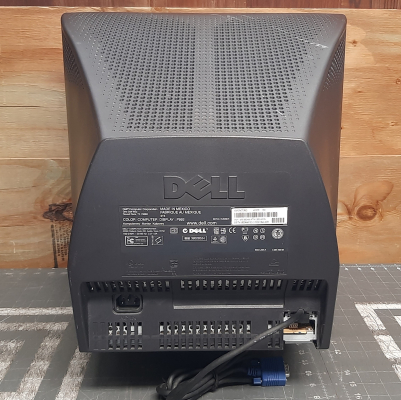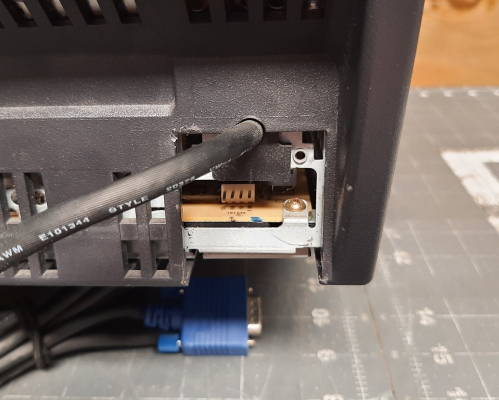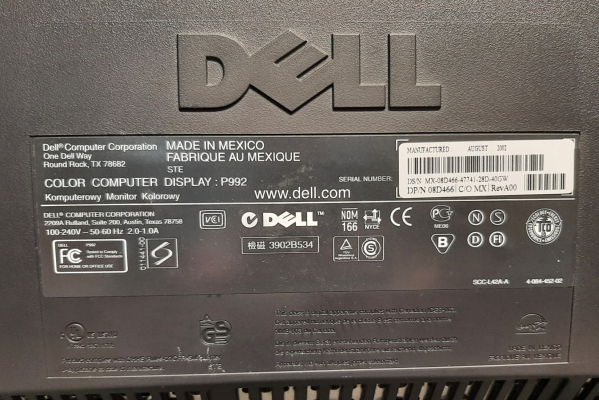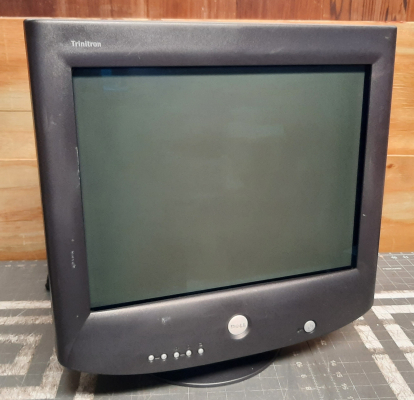Dell P992
August 30, 2024, 3:47 am
February 18, 2025, 8:15 am
Summary
One of the highest spec monitors in its size class, the P992 was manufactured by Sony and features a 19" flat Trinitron tube. It is based on the CPD-G410. Unlike the original, this monitor has a redesigned control panel with separate buttons for menu navigation. It is capable of a 107 kHz max horizontal scan rate.
Manuals
Notes
A small panel below the VGA cable can be removed to provide access to the serial pins for WinDAS calibration.
This monitor includes digital convergence controls, accessible through the OSD menu.
Brightness & Color Issues
PC Monitors made by Sony often have drifted out of calibration. This can result in poor color balance, excessive brightness, or other issues. These monitors often have an extremely bright picture, sometimes with a green tint. This cannot always be corrected with the OSD controls, and the monitor's firmware settings must be adjusted using WinDAS, Sony's proprietary calibration software.
This tube has a fragile anti-glare coating which will be damaged by all common cleaning products including Ammonia-Free products. You should only clean it with distilled water or distilled water mixed with a few drops of dish soap. Use only a soft clean microfiber towel to wipe the screen. I reccomend buying a spray bottle to mist the screen with the water or dish soap solution.
If the screen has missing/discolored parts of the finish, or spots that look like scratches that don't come off, or parts where the mirror finish is missing, the coating has already been permanently damaged and should be removed. You can find instructions for removing and replacing the film here.
Many brands used these coatings including Mitsubishi, Sony, JVC, IBM, and more. Usually if the underlying tube technology is aperture grille-based and the monitor is a higher performance PC monitor, it can be assumed the tube has this fragile coating. The user manual of the monitor will also mention not to use any cleaning products on the screen.
Here is an example of what permanently damaged glare coating looks like: Click to open Image
Gallery




| Specifications | |
|---|---|
| Brand: | Dell |
| Manufacturer: | Sony |
| Model: | P992 |
| Series: | UltraScan |
| Viewable Size: | 18" |
| Inputs: | VGA |
| Sync: | HV Sync, CSYNC, Sync on Green |
| Native Resolutions: | VGA, SVGA, XGA, SXGA, UXGA, QXGA |
| Horizontal Scan Range: | 30 kHz, 107 kHz |
| Vertical Scan Range: | 48 Hz, 170 Hz |
| Aspect: | 4:3 |
| Adjustments: | OSD Customer Controls, Software Calibration |
| Tube: | Sony FD Trinitron , M46LRR50X |
| Heater Voltage: | 6.3v |
| Deflection: | 90° |
| Mask: |
Aperture Grille

|
| Pitch: | .24 mm |
| Tint: | Dark |
| Removable Glare Film: | Yes |
| Speakers: | None |
| Chassis: | CRV |
| Weight: | 56 lbs (25.4 kg) |
| Dimensions (W/H/D): |
451 x 471 x 461 mm
(17.7 x 18.5 x 18.1") |
| Application: | Computer Monitor |
| Cabinet Material: | Plastic |
| Launched: | 2001 |
| Country of Manufacture: | Mexico |
| Mounting: | Desk Stand |
| Degaussing: | Automatic on Power-on, Manual |
| Tag: | Needs Pictures |

 This work is licensed under a
This work is licensed under a